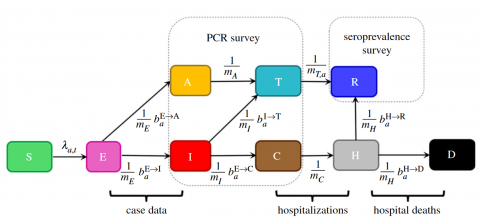Modelling Covid-19
Well parameterized epidemiological models including accurate representation of contacts are fundamental to controlling epidemics. However, age-stratified contacts are typically estimated from pre-pandemic/peace-time surveys, even though interventions and public response likely alter contacts. Here, we fit age-stratified models, including re-estimation of relative contact rates between age classes, to public data describing the 2020–2021 COVID-19 outbreak in England.
Background
Dynamic mathematical models, such as the susceptible–infectious–recovered transmission model and its numerous variants, have been widely applied over many decades to enhance understanding of infectious disease spread and control in populations. They have been particularly prominent in guiding public health responses to the Covid-19 pandemic, and are increasingly seen as important tools for causal inference in epidemiology. Model results used to inform public health decisions must be defensible, requiring models to be informed by, and be consistent with, the widest range of suitable data sources available. However, the Covid-19 pandemic has shown that tools to enable reliable and routine inference for sufficiently realistic models of disease dynamics from multiple sources of data are currently lacking.
BioSS’ role
Here, we address this gap by introducing a novel algorithm that enables efficient inference for complex compartmental models, illustrating its potential by fitting an age-structured national-scale model to multiple data sources (demographic, operational and survey data). This enables simultaneous inference of many key parameters describing the outbreak, and the benefits of such an integrated approach are exemplified by updating pre-pandemic age-stratified contact rates to account for relative differences in contact between age groups.
Publications:
C. M. Pooley, A. Doeschl-Wilson, G. Marion, Estimation of age-stratified contact rates during the COVID-19 pandemic using a novel inference algorithm. Phil. Trans. R. Soc. A 380 (2022) 20210298.
BEEP (Bayesian Estimation of Epidemiological Parameters) – A general-purpose software tool for simulating and performing inference on compartmental models from population level data. This software was used in the Covid-19 analysis.
Acknowledgements
This work was funded by RESAS, EPIC and DDI. We would like to acknowledge Helen Brown, Stella Mazeri and Margo Chase-Topping for many useful discussions and RSEs Ian Hinder and Robin Williams for their contributions in developing BEEP (the software used to perform the analysis). Also we express our gratitude to DiRAC for allowing us to use their HPC facilities for free during the pandemic.


